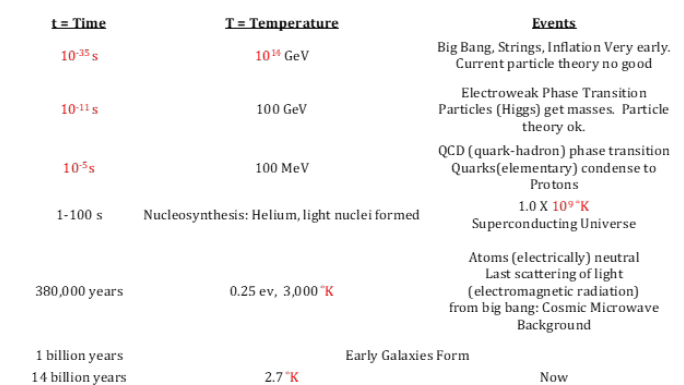- Submissions

Full Text
Evolutions in Mechanical Engineering
Brief Review of the Evolution and Nature of the Universe
Leonard S Kisslinger*
Department of Mechanical Engineering, Kanad Institute of Engineering and Management, India
*Corresponding author:Leonard S Kisslinger, Department of Physics, Carnegie Mellon University, Pittsburgh PA 15213, Pennsylvania, USA
Submission: July 22, 2022;Published: March 27, 2023

ISSN 2640-9690 Volume4 Issue4
Abstract
First there is a review of the Cosmic Microwave Background (CMBR) estimate of ordinary matter, dark matter and dark energy in the universe. Then there is a review of the evolution of the universe with two important cosmological events reviewed.
Keywords: Evolution of the Universe; Matter in the Universe
Introduction
In section 2 the Microwave Background Radiation (CMBR) experiments which estimates the types of Matter in the Universe is reviewed.
In section 3 the evolution of the universe with cosmological events as time increases and temperature declines is reviewed.
Note that the elementary particles are quarks, photons which create electromagnetic interactions and gluons which couple to quarks and antiquarks with a strong interaction that creates mesons (quarks and antiquarks) an baryons (three quarks).
Cosmic Microwave Background Radiation (CMBR)
There have been many CMBR experiments, such as Refs [1-4] which have estimated the total density of the present universe, Dark Matter density, dark energy density, etc.
With Ω the density of the Universe and Ω=1.0 for a flat Universe, recent results from CMBR
observations [5] are:
Ω=1.0023+0.0056-0.0054
Dark Energy Density (vacuum energy)=0.703±0.025
Dark Matter Density=0.273±0.019
Baryon (Normal Matter) Density≃0.04
Age of the Universe≃1.37 billion years (1)
Therefore about 27% of the Universe is Dark Matter. About 70% of the universe is dark energy, which is anti-gravity. Dark Energy (Quintessence) is antigravity and produced inflation at a very early time, which is why we now have an almost homogeneous universe. Only about 4% of the universe is normal matter.
The Evolution of the Universe
The evolution of the Universe is shown in the figure below. The time goes from the Big Bang at t=10−35 seconds when all elementary particles except the photon received their mass. A second important Cosmological event is the QCD Phase Transition (QCDPT) at t=10-5 seconds. Just before the QCDPT the Universe consisted of elementary particles. During the QCDPT quarks and antiquarks interacting via gluons formed mesons and baryons. seconds to 14 billion years when we have our present Universe (Figure 1). An important Cosmological events is the Electroweak Phase Transition (EWPT) at t=10-11 seconds when all elementary particles except the photon received their mass. A second important Cosmological event is the QCD Phase Transition (QCDPT) at t=10-5 seconds. Just before the QCDPT the Universe consisted of elementary particles. During the QCDPT quarks and antiquarks interacting via gluons formed mesons and baryons.
Figure 1:The evolution of the universe (overview).

References
- Fixen DJ, Cheng ES, Gales JM, Mather JC, Shafer RA, et al. (1996) The cosmic microwave background spectrum from the full COBE FIRAS data set. Astrophys J 473: 576.
- Reichardt CL (2008) (ACBAR). Astrophys J 674: 1200.
- Gupta S, Ade P, Bock J, Bowden M, Brown ML, et al. (2010) Parameter estimation from improved measurements of the cosmic microwave background from QUaD. Astrophys J 716: 1040.
- Hinshaw G, Larson D, Komatsu E, Spergel DN, Bennett CL, et al. (2013) Nine-year Wilkinson Microwave Anisotropy Probe (WMAP) observations: Cosmological parameter results.
- Erminia C, Renée AH, Richard BJ, Mark JD, Joanna D, et al. (2017) Cosmological parameters from pre-planck CMB measurements: A 2017 update. Phys Rev D95: 063525.
 a Creative Commons Attribution 4.0 International License. Based on a work at www.crimsonpublishers.com.
Best viewed in
a Creative Commons Attribution 4.0 International License. Based on a work at www.crimsonpublishers.com.
Best viewed in 







.jpg)






























 Editorial Board Registrations
Editorial Board Registrations Submit your Article
Submit your Article Refer a Friend
Refer a Friend Advertise With Us
Advertise With Us
.jpg)






.jpg)














.bmp)
.jpg)
.png)
.jpg)










.jpg)






.png)

.png)



.png)






